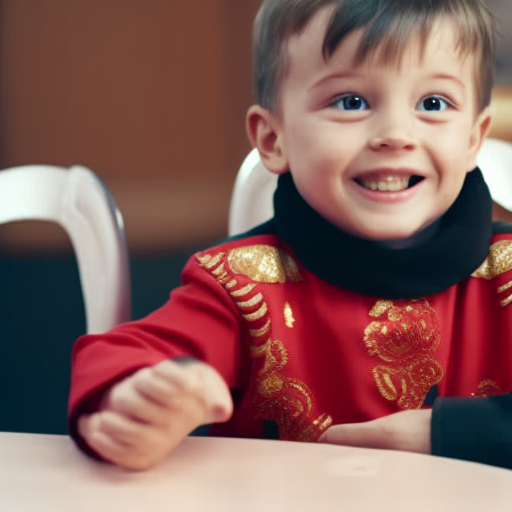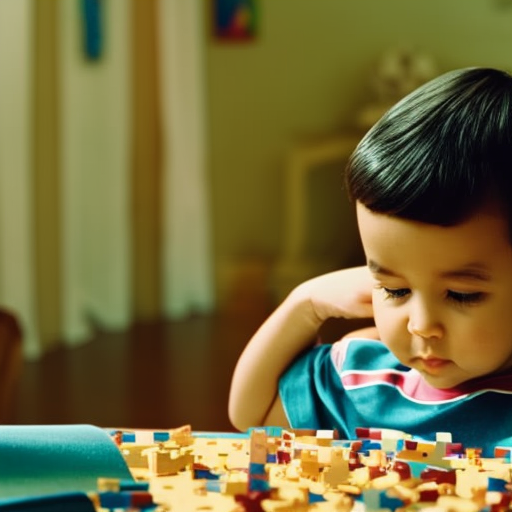"Cherishing Little Steps - A Haven for Baby and Family Journeys"
Understanding Five-Year-Old Milestones
Have you ever wondered what milestones your five-year-old should be reaching?
As a parent or caregiver, it is important to have a good understanding of the developmental stages your child is going through. From language development to cognitive skills, social and emotional growth to physical milestones, and fine motor skills to school readiness, there is a lot to unpack when it comes to understanding the progress of a five-year-old.
In this discussion, we will explore each of these areas in detail, providing you with valuable insights and tips to support your child’s development.
So, let’s dive in and discover the fascinating world of five-year-old milestones!
Key Takeaways
- Language Development: Five-year-olds have a rich vocabulary, can understand abstract concepts, and use longer and more detailed sentences. They can effectively communicate through conversations, explanations, and questions.
- Cognitive Skills: Five-year-olds have an increased attention span for complex activities, enhanced problem-solving skills, and the ability to categorize objects based on attributes. They can also understand and follow multi-step instructions.
- Social and Emotional Development: Five-year-olds are developing self-regulation skills, understanding and recognizing emotions of others, and showing empathy and compassion. They are learning to take turns, share, and cooperate with peers.
- Physical Milestones: Five-year-olds have improved gross motor skills, such as coordination and balance for running, jumping, and climbing. They also have refined fine motor skills, including a mature pencil grip and hand-eye coordination for accurate movements.
Language Development

By the age of five, your child has typically reached significant milestones in their language development. At this stage, they demonstrate a rich vocabulary, using words that are more specific and precise. Their vocabulary expansion is remarkable, with an average of 2,500 to 5,000 words in their repertoire. They’ve a greater understanding of abstract concepts and can grasp complex sentence structures. You’ll notice their sentences becoming longer and more detailed, using conjunctions such as ‘and,’ ‘but,’ and ‘because’ to connect ideas. Their sentence formation is becoming more advanced, allowing them to express their thoughts and ideas with clarity.
Moreover, their ability to engage in meaningful conversations with others is evident. They can provide detailed explanations, ask relevant questions, and express their emotions effectively. They understand and follow complex instructions, demonstrating their cognitive development. They also show an increasing awareness of grammar rules and use them more accurately in their speech.
To support your child’s language development, encourage conversations and provide opportunities for them to express themselves. Reading books together and discussing the stories can help expand their vocabulary and improve their sentence formation. Engaging in imaginative play and encouraging storytelling also fosters their language skills. By nurturing their language development, you’re setting a strong foundation for their future communication and cognitive abilities.
Cognitive Skills

At the age of five, your child’s cognitive skills have significantly developed, allowing them to think, reason, and problem-solve more effectively. Cognitive development refers to the growth and maturation of a child’s mental processes, including their ability to understand, remember, and use information.
Here are some key cognitive milestones you can expect to see in your five-year-old:
-
Increased attention span: Your child can now focus on a task for a longer period of time, allowing them to engage in more complex activities and explore new concepts.
-
Enhanced problem-solving skills: Five-year-olds begin to demonstrate more sophisticated thinking abilities, such as logical reasoning and the ability to solve simple puzzles or problems independently.
-
They can categorize objects based on various attributes, such as color, shape, or size.
-
They can understand and follow multi-step instructions, showing improved planning and organizational skills.
These cognitive advancements are a result of increased brain development and the accumulation of knowledge and experiences. Encourage your child’s cognitive growth by providing them with opportunities for exploration, critical thinking, and problem-solving. Engaging in activities that involve puzzles, games, and imaginative play can further stimulate their cognitive abilities.
Celebrate their achievements and offer guidance when needed, fostering a positive learning environment that nurtures their cognitive development.
Social and Emotional Development

As your child’s cognitive skills continue to develop, their social and emotional development also becomes increasingly important. At the age of five, your child is developing self-regulation skills, which refer to their ability to control their emotions, impulses, and behaviors. They’re becoming more aware of their own feelings and learning how to effectively manage them. This includes understanding the concept of empathy and compassion towards others.
During this stage, your child is starting to understand and recognize the emotions of others. They may show concern and empathy when someone is sad or hurt, and they may even try to comfort them. They’re also learning to take turns, share, and cooperate with their peers, showcasing their growing social skills.
Encouraging your child’s social and emotional development can be done through various activities. For example, engaging in pretend play allows them to explore different emotions and practice empathy towards their playmates. Reading books together about feelings and discussing them afterwards can also be beneficial. Additionally, teaching your child problem-solving strategies and conflict resolution skills can help them navigate social situations more effectively.
Physical Milestones
Physical milestones are important markers of a child’s growth and development. At five years old, your child is developing their gross motor skills and sensory development in significant ways. Here are some key points to consider:
Gross Motor Skills:
- Your child is becoming more coordinated and confident in their movements. They can now run, jump, and hop with greater control and balance.
- Climbing structures such as jungle gyms or ladders is now easier for them, as their muscles and coordination have improved.
- They’re refining their throwing and catching skills, allowing them to engage in more complex games and activities with peers.
Sensory Development:
- Your child’s senses are becoming more refined. They can now distinguish between different textures, temperatures, and tastes.
- They’re able to use their senses to explore and understand their environment more fully, which helps with their cognitive development.
- Activities that engage their senses, such as playing with sand, water, or different materials, can provide important sensory stimulation and promote their overall development.
Fine Motor Skills

Now let’s shift our focus to the development of fine motor skills in five-year-olds, as they continue to make significant progress in their physical milestones.
Fine motor skills refer to the ability to coordinate and control the small muscles in the hands and fingers. At this age, children are refining their pencil grip and hand-eye coordination, which are essential for tasks such as writing, drawing, and using utensils.
By the age of five, most children have developed a mature pencil grip. They can comfortably hold a pencil with their thumb and fingers, using a tripod grip where the pencil rests on the middle finger. This grip allows for better control and precision when writing or drawing. It’s important to encourage and support their grip development by providing age-appropriate writing tools and activities that promote hand strength and dexterity.
Hand-eye coordination is another crucial aspect of fine motor skill development. At five years old, children are improving their ability to coordinate their hand movements with what they see. They can now accurately guide a pencil or crayon within lines, copy more complex shapes, and complete simple puzzles. Engaging in activities that involve threading beads, playing with building blocks, or cutting with child-safe scissors can further enhance their hand-eye coordination.
As a parent or caregiver, you can support your child’s fine motor skill development by providing opportunities for them to practice their pencil grip and hand-eye coordination. Encourage them to engage in activities that require precise hand movements, such as coloring, tracing, and cutting. By nurturing these skills, you’re helping your five-year-old build a strong foundation for future academic and everyday tasks.
School Readiness

To ensure your five-year-old is prepared for school, it’s important to focus on their cognitive and social-emotional development. School readiness is crucial for a smooth transition into formal education. Here are some key areas to consider:
-
Language Development:
-
Vocabulary Expansion: Encourage your child to learn new words and use them in context. Engage in conversations and read books together to expose them to a wide range of vocabulary.
-
Communication Skills: Help your child express their thoughts and feelings effectively. Teach them to listen attentively and take turns during conversations.
-
Social Skills:
-
Peer Interaction: Provide opportunities for your child to interact with other children, such as playdates or preschool. This helps them develop important social skills like sharing, taking turns, and cooperating.
-
Emotional Regulation: Help your child identify and manage their emotions. Teach them strategies to calm themselves down when they’re upset or frustrated.
Frequently Asked Questions
What Are the Typical Sleep Patterns for a Five-Year-Old?
You’ll find that typical sleep patterns for a five-year-old involve around 10-12 hours of sleep per night, with the occasional nap. It’s important to establish a consistent bedtime routine and promote healthy eating habits for a well-rested and energized child.
How Can I Encourage My Five-Year-Old to Try New Foods and Develop Healthy Eating Habits?
To encourage your five-year-old to try new foods and develop healthy eating habits, it’s important to create a positive and supportive environment. Offer a variety of nutritious options, involve them in meal planning and preparation, and be a role model by eating healthy yourself.
What Are Some Common Challenges Parents Face When It Comes to Discipline and Behavior Management in Five-Year-Olds?
Discipline challenges and behavior management can be tough with five-year-olds. It’s important to establish clear rules and consequences, while also providing positive reinforcement and using effective communication techniques to guide their behavior.
What Are Some Strategies to Help Five-Year-Olds Develop Problem-Solving and Decision-Making Skills?
To help your five-year-old develop problem-solving and decision-making skills, engage them in problem solving activities and decision-making exercises. These activities will encourage their critical thinking abilities and empower them to make choices confidently.
How Can Parents Support Their Five-Year-Olds in Developing Independence and Self-Help Skills?
To support your five-year-old in developing independence and self-help skills, encourage them to take on age-appropriate tasks like dressing themselves, making choices, and completing simple chores. Praise their efforts and provide gentle guidance when needed.
Conclusion
In conclusion, understanding the milestones of a five-year-old is crucial for parents and caregivers to ensure proper development.
According to a study conducted by the American Academy of Pediatrics, it was found that by the age of five, children should be able to form sentences of five words or more. This statistic highlights the importance of language development at this stage and emphasizes the need for engaging activities to support their growing cognitive and social skills.
By nurturing these milestones, we can pave the way for a successful transition into school readiness.


